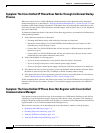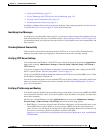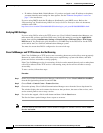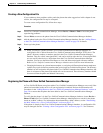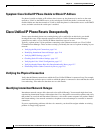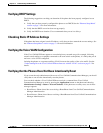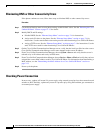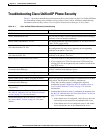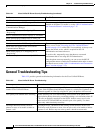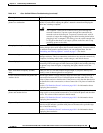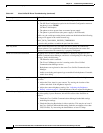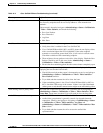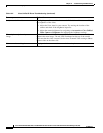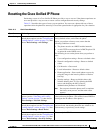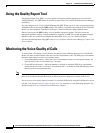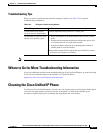
12-10
Cisco Unified IP Phone 8961, 9951, and 9971 Administration Guide for Cisco Unified Communications Manager 8.5 (SIP)
OL-20861-01
Chapter 12 Troubleshooting and Maintenance
General Troubleshooting Tips
General Troubleshooting Tips
Table 12-2 provides general troubleshooting information for the Cisco Unified IP Phone.
802.1X Not Enabled
Phone cannot obtain a DHCP-assigned IP address These errors typically indicate that 802.1X authentication is not
enabled on the phone. To enable it, see the “802.1X Authentication
and Transaction Status” section on page 7-15.
Phone does not register with Cisco Unified
Communications Manager
Phone status display as “Configuring IP” or
“Registering”
802.1X Authentication Status displays as “Disabled”
Status menu displays DHCP status as timing out
Factory Reset Deleted 802.1X Shared Secret
Phone cannot obtain a DHCP-assigned IP address These errors typically indicate that the phone has completed a
factory reset (see the “Resetting the Cisco Unified IP Phone”
section on page 12-15) while 802.1X was enabled. A factory reset
deletes the shared secret, which is required for 802.1X
authentication and network access.
To resolve this, temporarily move the phone to a network
environment that is not using 802.1X authentication.
Once the phone starts up normally, you can access the 802.1X
configuration menus to enable device authentication and to re-enter
the shared secret (see the “802.1X Authentication and Transaction
Status” section on page 7-15).
Phone does not register with Cisco Unified
Communications Manager
Phone status display as “Configuring IP” or
“Registering”
Cannot access phone menus to verify 802.1X status
Table 12-1 Cisco Unified IP Phone Security Troubleshooting (continued)
Problem Possible Cause
Table 12-2 Cisco Unified IP Phone Troubleshooting
Summary Explanation
Connecting a Cisco Unified IP Phone to
another Cisco Unified IP Phone
Cisco does not support connecting an IP phone to another IP phone through the
PC port. Each IP phone should directly connect to a switch port. If phones are
connected together in a line (by using the PC port), the phones will not work.
Poor quality with tandem audio encoding Tandem encoding can occur when making calls between an IP phone and a
digital cellular phone, when using a conference bridge, or in situations where IP
to IP calls are partially routed across the PSTN. In these cases, use of voice
codecs such as G.729 and iLBC may result in poor voice quality. Use these
codecs only when absolutely necessary.
Prolonged broadcast storms cause IP
phones to reset, or be unable to make or
answer a call
A prolonged Layer 2 broadcast storm (lasting several minutes) on the voice
VLAN may cause IP phones to reset, lose an active call, or be unable to initiate
or answer a call. Phones may not come up until a broadcast storm ends.



